| Having trouble viewing this email? View it as a Web page.  | | | Editor: Kelly Sprute June 9, 2021 Making a Difference 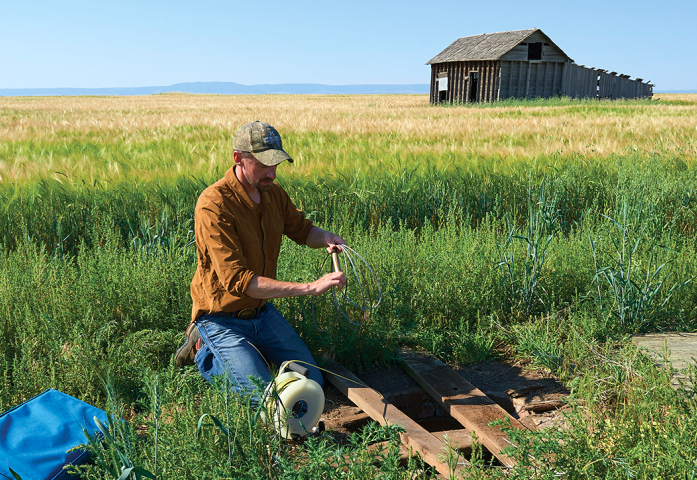 MSU researcher and Extension specialist Adam Sigler checks a data logger that has been recording groundwater levels in an abandoned well near a historic granary. Testing the Water Agriculture has driven the local economy of small central Montana communities for at least 120 years. Within the two counties' 6,400 square miles, there are more than 200,000 acres of wheat planted each year and fewer than 14,000 people. Historically, groundwater in the shallow aquifers of this area has contained a high level of nitrate, which can pose health risks to the community. Researchers from Montana State University (MSU), including MSU Extension, and Utah State University partnered with the community to identify the causes of the high nitrate concentration and try out agricultural practices that might reverse the problem. A four-year study that has led to ongoing research in the area, the Judith River Watershed Nitrogen Project, funded by a grant from USDA's National Institute of Food and Agriculture, has brought the university's land-grant mission to life using applied science to serve the needs of a rural Montana community. For more information, read the MSU article. | |  This week, many of our NIFA colleagues joined with our partners at the Extension Foundation, the Cooperative Extension System across the nation, and the Centers for Disease Control and Prevention to celebrate the launch of EXCITE – Extension Collaborative on Immunization Teaching and Engagement. Through an Interagency agreement between NIFA and the CDC, the Cooperative Extension System will work nationwide to deliver vaccine education and address health disparities in rural and medically underserved communities. The Extension Foundation reports they received 72 applications for the first activity – systemwide engagement with the CDC's Vaccinate with Confidence campaign. An additional opportunity for adult immunization education pilot projects reaped 30 applications involving 38 land-grant institutions across five Extension regions. Of those, 24 were selected for funding. This program required a lot of fast work and dedication from a host of experts. Atop the list are University of Delaware Extension Director Michelle Rodgers, who leads the Extension Health Innovation Task Force, and Chris Geith, CEO, Extension Foundation. Also contributing, CDC Epidemiologist Alexi Piasecki and NIFA National Program Leader Brent Elrod. They and their respective colleagues pulled together an Interagency Agreement, developed, issued, and responded to an RFA, and got funding out the door in six months. Those of us in Federal service know that's no easy feat! I started my career in the Cooperative Extension Service. The lessons I learned there set me on the path that led me to NIFA. Over the years, I've often marveled at the ingenuity, innovation, and determination of our Extension colleagues. Over the past year, as we found our way through the pandemic, for so many in communities large and small across America, the guiding light ahead was an Extension agent, a 4-H leader or volunteer, an Extension specialist showing the way to a brighter tomorrow. Extension has once again proven to the nation why their system is the envy of the world. No matter the challenge, for more than 100 years, Extension has been there to elevate, educate and serve. I'm so proud to have them as our NIFA partner. Dr. Carrie Castille
Director, National Institute of Food and Agriculture | 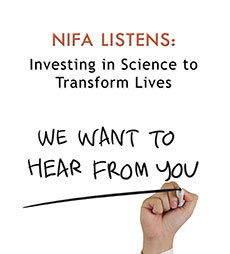 Save the Date – NIFA Virtual Stakeholder Listening Session The U.S. Department of Agriculture (USDA), National Institute of Food and Agriculture (NIFA) will conduct a virtual listening session from 11 a.m. to 12:30 p.m. (Central) on Thursday, June 17, 2021. The purpose of the virtual listening session is to seek stakeholder input on future priorities for NIFA research, education, and extension programs. Input may be submitted by: - Participating in a virtual stakeholder listening session on Thursday, June 17 from 11 a.m. to 12:30 p.m. (Central). Each participant may speak for up to 3 minutes. Register online in advance to attend this virtual listening session. After registering, you will receive a confirmation email containing information about joining the webinar.
- Sending written comments (1-page limit) to: NIFAlistens@nifa.usda.gov by June 24, 2021.
|  Exploring Lessons Learned from COVID-19 The food supply chain is a complex structure. To little surprise, the system experienced disruptions due to the pandemic. The project, "Lessons from COVID-19: Positioning Regional Food Supply Chains for Future Pandemics, Natural Disasters and Human-made Crises," University of Minnesota professor of applied economics Hikaru Peterson, was funded by USDA National Institute of Food and Agriculture's Agriculture and Food Research Initiative as part of the COVID-19 Rapid Response grant program. The research "takes a rigorous look at the resilience of the U.S. food system to explore the extent that local and regional food systems can effectively augment mainstream supply chains to meet the nation's food needs during future natural and human-made crises," Peterson said. For more information, this NIFA blog by guest author, University of Minnesota Professor Hikaru Peterson, PhD. Photo of supermarket cart in an aisle, courtesy of Getty Images. | 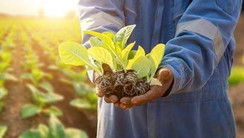 USDA Seeks Proposals for Fiscal Year 2022 Plant Protection Act Section 7721 and National Clean Plant Network Program Projects The USDA's Animal and Plant Health Inspection Service (APHIS) invites stakeholders to submit project suggestions for fiscal year 2022 Plant Protection Act (PPA) Section 7721 funding. In total, APHIS will allocate approximately $75 million to plant protection funding with at least $5 million going to the National Clean Plant Network. PPA 7721's Plant Pest and Disease Management and Disaster Prevention Program is a cooperative agreement program established by the Farm Bill that allows APHIS and its partners to prevent, detect, and mitigate invasive plant pests and diseases. Funding is available for land-grant universities, non-land-grant colleges of agriculture, State agricultural experiment stations, State and Federal agencies, and non- governmental organizations. For more information, visit APHIS online. Farmer holding plantings, courtesy of Getty Images. |  USDA to Strengthen Food System Citing lessons learned from the COVID-19 pandemic and recent supply chain disruptions, the USDA recently announced plans to invest more than $4 billion to strengthen critical supply chains through the Build Back Better initiative. The new effort will strengthen the food system, create new market opportunities, tackle the climate crisis, help communities that have been left behind, and support good-paying jobs throughout the supply chain. Funding is provided by the American Rescue Plan Act and earlier pandemic assistance such as the Consolidated Appropriations Act of 2021. For more information, read the USDA press release. |  Going Head-to-Head: Beef Patties vs. Plant-Based Alternative Patties How do plant-based hamburger patties compare to traditional beef patties? The results of a scientific study may surprise you. USDA's Gary Crawford talks with Kansas State University Associate Professor Travis O'Quinn about the blind taste test comparing beef with the alternative plant-based patties. For more information, listen to the USDA broadcast. Grilled hamburger patties, courtesy of Getty Images. |  NIFA Career Opportunities We are hiring! Remember to check out NIFA's Career Opportunities webpage, where there is a direct link to all open positions. You can also explore NIFA jobs at the USAjobs.gov website. Current openings in Kansas City, Missouri: Biological Science Specialist (Data Analyst) (GS-13)
Closing Date: 06/10/2021 Visual Information Specialist (GS 9-11)
Closing Date: 06/18/2021 | 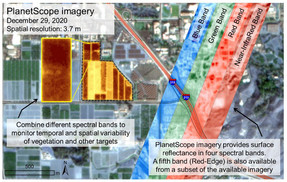 Earth-Spanning Satellite Images Now Available to Everyone Planet Labs Inc. has 200-plus satellites that monitor Earth's landmass daily. Their images range in spatial resolution from approximately 10 to 16 feet, and archived images are also available. The University of California Riverside (UCR) community has been invited to use this imagery for research and education activities. "Our project's license gives faculty, researchers, educators, staff, and students the ability to benefit from this imagery," said Elia Scudiero, a UCR researcher and principal investigator of the project titled, "Artificial Intelligence for Sustainable Water, Nutrient, Salinity, and Pest Management in the Western U.S." The project, funded by USDA's National Institute of Food and Agriculture, is working to improve the sustainability of irrigated agriculture in California and the U.S. Southwest. For more information, read this University of California Riverside article. PanetScope imagery over a portion of the UCR campus. Courtesy of Elia Scudiero, UCR. | 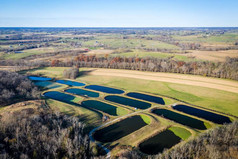 Study Examines Link Between Water Quality and Economic Development The American Society of Civil Engineers reports that the average age of wastewater treatment facilities in Kentucky is 36 years old, with some pipes more than 70 years old. Kentucky's water and wastewater systems are aging, and a lack of funding in some areas has contributed to systems not being able to maintain standards necessary for good health. The University of Kentucky's Community and Economic Development Initiative of Kentucky is teaming with Communities Unlimited in Arkansas and the Urban Institute in a three-year study to analyze the role of site-specific water and wastewater infrastructure quality, capacity and noncompliance on rural economic development and growth. Funding for this project comes from a rural economic development award from USDA's National Institute of Food and Agriculture. For more information, read this University of Kentucky article. Water treatment lagoons in rural Kentucky. Courtesy of Getty Images. |  The U.S. Israel Binational Agricultural Research and Development BARD Fund BARD projects focus on increasing agricultural productivity, particularly in hot and arid climates, and emphasize plant and animal health, food quality and safety, and environmental issues. BARD also supports international workshops, and offers fellowships for postdoctoral research, senior research scientists and graduate students. The primary rationale of BARD is bringing together American and Israeli scientists to address important agricultural challenges that concern both countries. Fostering this cooperation creates a synergy which generates results that would not be possible had the scientists worked independently. To learn more about the proposal opportunity, go online to BARD. | 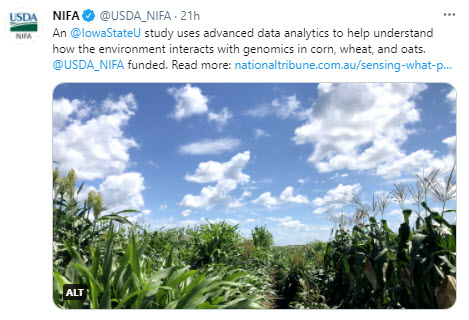 | | | NIFA's mission is to invest in and advance agricultural research, education, and extension that solve societal challenges. NIFA's investments in transformative science directly support the long-term prosperity and global preeminence of U.S. agriculture. Keep informed about NIFA, USDA, our land-grant and non-land-grant university partners, and stakeholders with the NIFA Update. Read past issues online, sign up for email updates or follow us on Twitter @USDA_NIFA, #NIFAImpacts or LinkedIn @usda-nifa. If you wish to submit a news item or information, send an email to NIFAUpdate. USDA is an equal opportunity lender, provider, and employer. | | | |

No comments:
Post a Comment